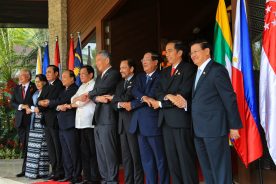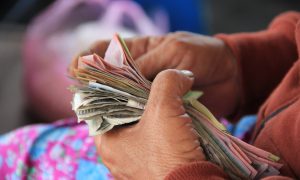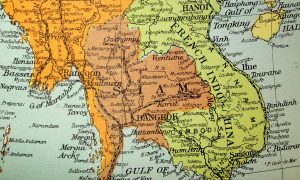A previous version of this paper was published in Italian, as “Un nuovo ritmo nei rapporti tra l’Australia e l’ASEAN”, RISE Relazioni internazionali e International political economy del Sud-Est asiatico, 21 July 2020, Vol. 5, No. 1, pp. 2-4. This English language version is published in partnership with the Torino World Affairs Institute.
In the bustling commercial and hotel districts of Southeast Asia’s big cities, you do not usually have to wait long before you hear an Australian accent. While the federal government in Canberra once proclaimed the intention for a foreign policy that is “more Jakarta, less Geneva,” millions of Australians got on with the job of understanding Southeast Asia, up-close, and personal. Bali is part of this equation as a cultural and holiday hotspot, but increasingly Australians have become a feature of the entire region’s economic, cultural and educational landscape.
It is natural that some end up overlooking the millions of small ties that have brought Southeast Asia and Australia closer together. Analysts and academics still often lament the lack of depth in these interactions and the inability of Australians to look beyond Southeast Asia as an exotic and distracting leisure destination. Australian language skills for Southeast Asia engagement are a common topic of dismay. Notwithstanding any perceived limitations, over the past two decades, inexpensive and constant flights to all corners of the Southeast Asian region opened up new frontiers for Australian tourists and business people, and analysts, and academics. We all benefited from the convenience of cross-cultural interaction, and many of us have learned how to say Phuket or Yogyakarta without any hesitation.
Southeast Asians have also sought to get to know Australia. Every year countless eager Malaysian, Thai, Indonesian and Vietnamese students take the next steps in their education in Melbourne, Armidale, Perth, and Hobart. A proportion of these students never leave, opting for an Australian lifestyle, and usually for Australian citizenship, as they pursue opportunities in towns and suburbs from Burnie to Broome. Migration to Australia has proved an attractive prospect, especially for groups who have found life difficult back home: Vietnamese democrats, Malaysian Chinese, Indonesia’s LGBTIQ+, the Rohingya. In the most recent census, almost 900,000 people, which is 14.2 percent of Australia’s overseas-born population, were from Southeast Asia.
Southeast Asia is nowadays second only to Northwest Europe as a source of foreign-born Australian citizens. In day-to-day practice, Australian society is marked by vibrant Southeast Asian voices and visions, with all manner of resilient personal, political, trade, and cultural connectivity. It is no surprise that ambitious government officials in Canberra often seek opportunities for postings and other work in Southeast Asia. Jakarta, Singapore, Bangkok, Yangon, Hanoi: they all look good on a CV, particularly for those who want to play central roles in Australia’s increasingly challenging geopolitical dance.
Strategic concerns
The rhythm of that dance is set by the Association of Southeast Asian Nations. It has sought to welcome Australian perspectives while ensuring “ASEAN centrality,” a defensive doctrine of non-interference, continues to hold sway. Australia – like China, Japan, and South Korea – has invested heavily in Southeast Asian multilateralism, judging, quite rightly, that regional peace and prosperity requires constant attention to potential flashpoints. Over the past five years, the challenge has been the increasingly assertive diplomatic and military posture determined by Beijing. Muscular Chinese initiatives have emerged while the United States, distracted by its internal affairs, has failed to retain the confidence of Asian allies. Australia, as a longstanding and steadfast backer of American primacy, has needed to make some adjustments.
The harsh reality for Australian decision-makers is that we only ever figure at the margins in Washington or Beijing. We know that our economy, still the world’s 13th largest, is a crucial source of imports for China’s industrialisation, and for its increasingly picky middle-class consumers, but that does not readily translate to influence at the world’s top tables. Australia’s approach to creative, middle power diplomacy has long struggled with perceptions that our foreign policy elites hold a worldview that always puts America first. Sophisticated Southeast Asian and Chinese analysts appreciate these tensions and understand the difficult choices for any Australian government that seeks to change what have been long-lasting and beneficial alliance arrangements.
What has happened since the COVID-19 pandemic erupted from central China in early 2020 will require scrutiny for decades to come. Competitive pressure has built up between the United States and China, and much diplomatic, economic and social certainty has eroded through the patchy global response to this new coronavirus. During the pandemic, Australia’s foreign policy debate has become even more preoccupied with the respective strengths and weaknesses of the Chinese and American political models. Australia, almost uniquely, relies on both powers for its security and its prosperity, in a framework that is now tested on all sides.
Southeast Asian nations face a similar set of policy challenges and have proved understandably reluctant to make a choice in favour of Beijing’s or Washington’s prescriptions. Whether their postures are described as balancing, or hedging, or simply as fancy footwork, they end up seeking to create space, across the region, for pragmatic interaction and flexible policy. Choosing a side is deemed undiplomatic and even impolitic in the terms favoured by ASEAN’s evolving ideology of cooperative agnosticism. Helpfully, the ten countries of the ASEAN offer differing emphasis and so the grouping, as a whole, has some variety to assuage the many critics.
Indeed, within many Southeast Asian countries, there are multiple approaches to the fast-changing geopolitical terrain. Myanmar, which is admittedly an extreme example, is home to influential ethnic armed groups that have proved resilient foreign policy players, able to carve out zones of control, supported by strong international backers, over many decades. Even within Thailand, the Philippines, or Indonesia, there are locally defined expectations of Chinese and American power. Major commercial, military, and political players hedge their bets, seeking to convince both sides of their openness to cooperation.
Upheaval and uncertainty
The sustainability of these arrangements in Southeast Asia is a key question for Australia. Recent decades of relative economic success and political stability have certainly smoothed out the intensity of Australian concern about nightmare scenarios of regional strife and national implosions. While terrorist attacks in the region, especially in Indonesia, Thailand, and the Philippines, have required a great deal of Australian analytical attention, the overall region’s security has not faced any recent test of real severity. It is easy to expect that benign conditions will continue, but is it a rational response, especially now that the pandemic has upended so many other supposed certainties?
What we know already is that COVID-19 will continue to showcase wildly different responses from different political and economic systems. It is also likely that some of the biggest challenges will emerge across Asia, in terms of devastating health outcomes and economic consequences. Battles for legitimacy, already a persistent part of the regional landscape, will now be aligned to the assessment of response successes and failures. Under these conditions, governments will fall. Some societies may fracture.
From Australia, we keep an eye on the vast archipelagos in Southeast Asia. These are places where the pandemic’s many ramifications will matter for the next generation and the one after that. Regime protection is a strong instinct everywhere, often with violence. There are already plenty of examples of men with batons beating up the non-compliant. Dictators and bullies, including in Southeast Asia, will find new space through this ongoing crisis.
Australians are also naturally concerned that a further set of complications will emerge on the other side of the pandemic. With around 650 million people just in Southeast Asia, some societies and groups will inevitably become stronger after this crisis. But it will likely only further entrench inequalities, particularly as the poorer and more unequal societies struggle to find adequate responses. The disaster still unfolding in the United States could be replicated in many parts of Southeast Asia over the year ahead, with even more severe consequences.
As analysts, we cannot assume that societies recover from the rupturing that follows, and countless lives will be in the balance. Inter-generational inequalities will be exacerbated in many places, with tragic outcomes for vulnerable communities, particularly for women, girls, religious and ethnic minorities, displaced people, refugees, and those already living in heavily militarised contexts.
Next steps
So, what can Australia do to support our Southeast Asian friends at this challenging time? If our generations of diplomacy, collaboration, and creative partnership are worth anything, Australia will want to step up in the region over the years ahead. Such foreign policy and humanitarian initiative will not be easy given the incredible requirements to re-invest in Australian society for the long-term. The Australian government’s budget and the overall national economic picture are much worse now than at any time in living memory.
Yet it is not a time to turn our backs on Asia, particularly Southeast Asia and adjacent areas. The prognosis for countries like Indonesia and Bangladesh is bleak, at least in economic terms. The tendency now to pull back from the world will be overwhelming, but Australia has always done its best work when it shares its wealth, security, and opportunity with its friends.
That was undoubtedly the successful pattern of innovation and engagement after the Second World War. Just like in 1946, we do not have to accept everything that was wrong with the world in 2019 being replicated, anew, in post-COVID Southeast Asia or Australia. There is a chance to build better institutions and more in-depth cooperation, with less tolerance for the narrow-mindedness and pettiness that has proved so attractive over the years. Without labouring the point, surely those of us who live through the crisis owe it to everyone, including those who struggle to survive, to make a fairer world for all.
Next year, or the year after, Australians will likely be back, in large numbers, across Southeast Asia. Flights will resume and hotels will fill up. Australian money will still be warmly welcomed. Indeed, Australia’s success in minimising the pandemic’s health consequences will also be looked at favourably, especially where the lessons and relevant technology can be generously shared.
ASEAN’s myths: creating continuity, rather than change
ASEAN's human rights mechanisms reflect the body's prioritising the interests of national elites. Don't expect it to be of use in resolving the Rohingya crisis.
Without implying cynical motivations, Australian humanitarian support will have a significant reputational and strategic upside during this period. China’s pandemic diplomacy has already raised eyebrows, and, with proper management, Australian officials can avoid similar missteps. Sadly, the United States is struggling even to look after its own people. Under these remarkable new circumstances, the dance between Southeast Asia and Australia, and all of the other partners, will continue. It will be up to a new generation of leaders, from Southeast Asia and from Australia, to decide on how positive relations can continue to be built at a time of such upheaval and uncertainty.
 Facebook
Facebook  Twitter
Twitter  Soundcloud
Soundcloud  Youtube
Youtube  Rss
Rss 



